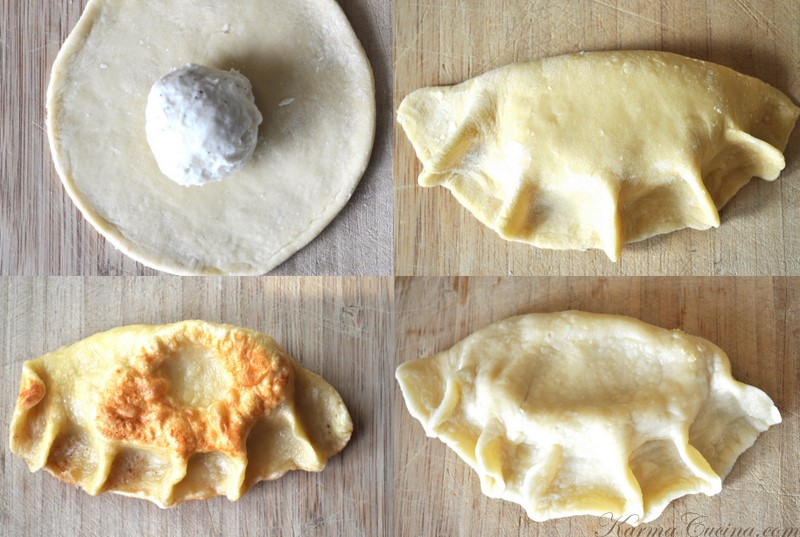 Taste and smell have a way of evoking memories of the past. When Easter comes to mind (religion aside), it’s not the gathering on Sunday that I think about, but actually the night before. Every Easter Saturday for as long as I can remember, we would indulge in a feast of kielbasa and my Grandma Mary’s homemade pierogi. Usually the week or one of the weeks leading up to it, Grandma would voyage down to the Jersey shore and visit with my
Taste and smell have a way of evoking memories of the past. When Easter comes to mind (religion aside), it’s not the gathering on Sunday that I think about, but actually the night before. Every Easter Saturday for as long as I can remember, we would indulge in a feast of kielbasa and my Grandma Mary’s homemade pierogi. Usually the week or one of the weeks leading up to it, Grandma would voyage down to the Jersey shore and visit with my
family. During this time she would put her arthritis-stricken hands aside, throw on a comfy cotton house dress, and transform my mother’s kitchen into a pierogi factory by making potato and cabbage fillings, kneading dough, and stuffing, boiling, and laying out pierogi by the hundreds. Similar to a mother squirrel preparing for a long cold winter, Grandma Mary would make enough pierogi for her kids and grandkids to divvy up amongst themselves and feast on all year long. She performed this labor of love throughout her seventies, most of her eighties, and finally retired from doing it a couple years before she passed at the age of ninety. Fortunately, I was lucky enough to apprentice her most of those years and learned a lot of her techniques at a young age. My favorite times – and much to her dismay – were when one of the pierogi would open up in the pot of boiling water despite her best efforts to seal them. I would gladly retrieve the damaged goods and munch on the semi-raw dough and whatever potato or cabbage filling hadn’t leaked into the rapidly bubbling water. But really,  who was she kidding with that momentary disappointed glance? She would join in on the undercooked pierogi snack seconds later… Another favorite memory was when our beloved golden retriever, Jessie, hijacked about three dozen pierogi that Grandma had laid out on the towel-covered counter to dry. Upon discovery of the theft, the four-legged pierogi burgular didn’t even wait to be yelled at – she marched right into her cage and shut the door behind her. Jessie whispered to me later that day, that despite the bellyache, it was all worth it…
who was she kidding with that momentary disappointed glance? She would join in on the undercooked pierogi snack seconds later… Another favorite memory was when our beloved golden retriever, Jessie, hijacked about three dozen pierogi that Grandma had laid out on the towel-covered counter to dry. Upon discovery of the theft, the four-legged pierogi burgular didn’t even wait to be yelled at – she marched right into her cage and shut the door behind her. Jessie whispered to me later that day, that despite the bellyache, it was all worth it…
We lost Grandma a few years ago and, with the exception of one year when I stepped up and decided to be the family’s pierogi purveyor, this tradition died with her. We certainly miss these delightful dumplings, but we miss her even more. In reviving the custom this Easter season, I hope to shine a light on her memory and sustain a piece of family tradition to pass along to future generations. I hope that when my family hears the pierogi browning and blistering in the crackling butter and smells the fragrant kielbasa simmering, they’ll reflect on their own memories of Grandma and Easter past. In sharing it with you, I don’t necessarily hope you make pierogi. Instead, I hope you reflect back on your family’s lost traditions and recipes and consider taking a stake in the legacy that is passed on to your future generations. In a world of dollar-menus, TV dinners, and instant gratification, isn’t it nice to have some traditional fare that’s been prepared and eaten the same way today as it was a hundred years ago? Do you have any old family recipes or traditions that you carry on today? I’d love to hear about them.
Potato Pierogi
Yields 50
Filling:
4 pounds eastern white potatoes
Salt
Fresh ground pepper
1 stick butter
2 medium sized onions, diced
8 ounces cream cheese
8 slices white American cheese
Dough (1 batch – need to make 5 times):
2 cups flour
2 eggs
½ cup warm water
½ tsp. salt
Filling:
Fill a large pot about 2/3 of the way with cold water and 1 1/2 tablespoons of salt. Peel and quarter potatoes and put pieces in the pot as you go along to prevent discoloration. Put the pot on the stove over high heat. Once it reaches a rapid boil, reduce heat to medium and keep at a rolling boil for approximately 20 minutes. The potatoes are done when they can easily be broken apart with poke of a fork.
While the potatoes are cooking, melt butter in a large skillet over medium heat and then add onions. Saute for approximately 7 minutes until onions are soft and translucent. Be careful not to brown.
You’re going to have to act quick here to take advantage of the heat: Drain the cooked potatoes in a colander and return immediately to the hot pot. Add onions and their juice, cream cheese, and American cheese. Whip for 30 seconds with a hand mixer. Taste for salt and season accordingly. I used 3/4 teaspoon of salt here, but also used salted butter, so if you used unsalted butter you may need a bit more. Add about 1/2 tablespoon of freshly ground pepper. This requires a lot of grinding, but it is one of the notable characteristics of her filling. Whip again with mixer until smooth and no lumps remain. The filling should be noticeably flecked with black pepper grinds. Use a spatula to transfer the potato mixture to a glass dish. Let cool to room temperature before using to fill or refrigerate overnight.
Dough:
Put flour in a large bowl and create a well in the middle. Fill well with eggs, water, and salt. Beat these three ingredients with a fork and then start to work in the surrounding flour until all four ingredients are completely mixed. Turn dough onto a floured surface with plenty of flour on hand. Knead by hand cutting in flour until dough is smooth, moderately firm, and elastic.
Each batch of this dough will yield 9 – 12 pierogi. You will need to repeat this process five times to utilize all of the filling.
Making pierogi:
Fill a large pot with water and a few tablespoons of olive oil. Bring to a boil over high heat. In the meantime, flour a rolling pin and roll dough into a large circle. Do not roll it too thin to the point where it is nearly transparent. Use a 5-inch round cutter and cut circles into the dough. Gather scraps and roll out again to cut additional circles. Repeat until no dough remains. Put approximately 3 tablespoons of filling in the center of each circle and fold like a taco. Flour your fingertips, push the dough together, and fringe the ends tightly so that nothing can escape. This step is extraordinarily important – do not rush or skimp on your efforts to seal tightly. Add pierogi to the boiling water and cook for approximately 7 minutes, stirring gently occasionally. Be sure not to overcrowd the pot or they will stick together or to the sides. I have found that 8 pierogi work well in my pot, but more or less may be appropriate for you depending on the size of yours. Transfer each pierogi to a large pot of cold water using a mesh skimmer and let cool for approximately 10 minutes. Use skimmer again to transfer pierogi to a dish towel lined workspace. Allow pierogi to dry for a couple of hours before refrigeration and/or freezing.
Repeat process until all filling is gone.
Preparation:
Melt butter in skillet and fry pierogi until golden brown on each side.
A few notes:
- Grandma always made the filling a day in advance and this was probably for a couple reasons: (1) you cannot fill the dough with hot potato filling and (2) this is a time-intensive feat from start to finish and best broken up into a two day project.
- Be careful not to under- or over- stuff the pierogi. If you do the former, they won’t be that tasty. If you do the latter, they’re probably going to open up. I suggest approximately 3 tablespoon of filling, but depending on the size of your cutter and the thinness you rolled the dough, you need to figure out what feels right.
- It’s normal to get 1 “wounded soldier” (pierogi that opens up in the boiling water) per batch of dough. If you are getting more than this, regroup and focus your sealing efforts for the next batch.
- Pierogi will refrigerate up to 1 week, but they also freeze well. If freezing, use wax paper and/or a product like “Press and Seal” to separate individual pierogi before freezing. I like to put a piece of wax paper between two and wrap the two-pack with the “Press and Seal” before throwing a few of these bundles into a larger resealable freezer bag.
- If you decide to throw in the towel because your hands can’t crimp anymore pierogi, the potato filling makes a spectacular side dish.





















They look AMAZING! I can see why your Grandma only made these once a year.
Nice tribute! You did a great job keeping her tradition alive. Your pierogi’s were great!
I agree with Lisa — that is a very nice tribute!
My husband is a big fan of pierogi, and I’ve made them only once, many months ago, so your post is inspiring me to make some again soon.
Thanks, Claudie!
The fact that you’ve made pierogi within “months” is impressive! Pierogi-making is very labor-intensive, but always worth it : )
wonderful post! you grandmother is surely smiling down on you 🙂
go, jessie, go!!! you are our hero! ~ love, higgins and grimm
happy easter!
Thanks, Melissa, Lisa, and Leslie! Happy Easter to all…
Hi! Just thought I’d leave a comment to tell you that I’ve made this recipe several times over the last few years, and love it! Thanks so much for sharing 🙂
This makes me so happy to hear : ).